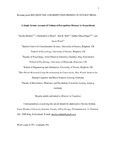A Single System Account of Enhanced Recognition Memory in Synaesthesia
| dc.contributor.author | Rothen, N | |
| dc.contributor.author | Berry, Christopher | |
| dc.contributor.author | Seth, A | |
| dc.contributor.author | Oligschläger, S | |
| dc.contributor.author | Ward, J | |
| dc.date.accessioned | 2019-11-28T12:59:04Z | |
| dc.date.issued | 2020-02 | |
| dc.identifier.issn | 0090-502X | |
| dc.identifier.issn | 1532-5946 | |
| dc.identifier.uri | http://hdl.handle.net/10026.1/15205 | |
| dc.description.abstract |
<jats:title>Abstract</jats:title><jats:p>Researchers often adjudicate between models of memory according to the models’ ability to explain impaired patterns of performance (e.g., in amnesia). In contrast, evidence from special groups with enhanced memory is very rarely considered. Here, we explored how people with unusual perceptual experiences (synaesthesia) perform on various measures of memory and test how computational models of memory may account for their enhanced performance. We contrasted direct and indirect measures of memory (i.e., recognition memory, repetition priming, and fluency) in grapheme–colour synaesthetes and controls using a continuous identification with recognition (CID-R) paradigm. Synaesthetes outperformed controls on recognition memory and showed a different reaction-time pattern for identification. The data were most parsimoniously accounted for by a single-system computational model of the relationship between recognition and identification. Overall, the findings speak in favour of enhanced processing as an explanation for the memory advantage in synaesthesia. In general, our results show how synaesthesia can be used as an effective tool to study how individual differences in perception affect cognitive functions.</jats:p> | |
| dc.format.extent | 188-199 | |
| dc.format.medium | ||
| dc.language | en | |
| dc.language.iso | en | |
| dc.publisher | Springer Verlag | |
| dc.subject | Memory | |
| dc.subject | Recognition | |
| dc.subject | Repetition priming | |
| dc.subject | Synaesthesia | |
| dc.subject | Signal detection | |
| dc.title | A Single System Account of Enhanced Recognition Memory in Synaesthesia | |
| dc.type | journal-article | |
| dc.type | Journal Article | |
| dc.type | Research Support, Non-U.S. Gov't | |
| plymouth.author-url | https://www.webofscience.com/api/gateway?GWVersion=2&SrcApp=PARTNER_APP&SrcAuth=LinksAMR&KeyUT=WOS:000519451000003&DestLinkType=FullRecord&DestApp=ALL_WOS&UsrCustomerID=11bb513d99f797142bcfeffcc58ea008 | |
| plymouth.issue | 2 | |
| plymouth.volume | 48 | |
| plymouth.publication-status | Published | |
| plymouth.journal | Memory and Cognition | |
| dc.identifier.doi | 10.3758/s13421-019-01001-8 | |
| plymouth.organisational-group | /Plymouth | |
| plymouth.organisational-group | /Plymouth/Faculty of Health | |
| plymouth.organisational-group | /Plymouth/Faculty of Health/School of Psychology | |
| plymouth.organisational-group | /Plymouth/REF 2021 Researchers by UoA | |
| plymouth.organisational-group | /Plymouth/REF 2021 Researchers by UoA/UoA04 Psychology, Psychiatry and Neuroscience | |
| plymouth.organisational-group | /Plymouth/Users by role | |
| plymouth.organisational-group | /Plymouth/Users by role/Academics | |
| dc.publisher.place | United States | |
| dcterms.dateAccepted | 2019-11-24 | |
| dc.rights.embargodate | 2020-1-28 | |
| dc.identifier.eissn | 1532-5946 | |
| dc.rights.embargoperiod | Not known | |
| rioxxterms.versionofrecord | 10.3758/s13421-019-01001-8 | |
| rioxxterms.licenseref.uri | http://www.rioxx.net/licenses/all-rights-reserved | |
| rioxxterms.type | Journal Article/Review | |
| plymouth.funder | Models of Explicit and Implicit Memory: Linking Priming, Recognition, and Source Memory::ESRC |


